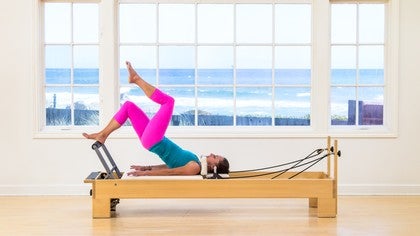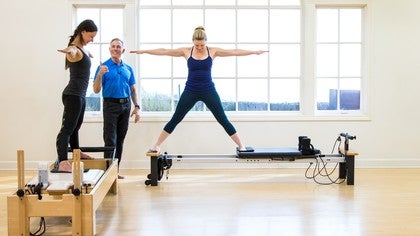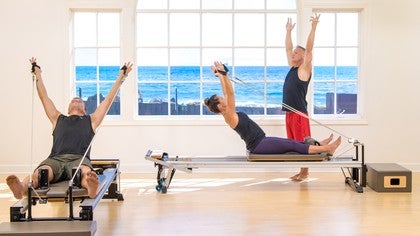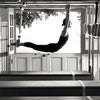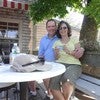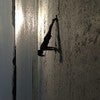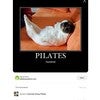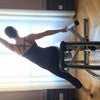Description
About This Video
Transcript
Read Full Transcript
It's come to my attention that there are a few of you out there who would like some Reformer classes with no box. So, if you'll notice, we don't have a box. I hope that makes you excited. I'm excited. We're also gonna focus on a little bit of unilateral work today.
I want you to just stand in front of your Reformer. I have one red spring on the Reformer. Starting by just organizing. Hello, train. Feeling the knees over the ankles, the pelvis over the knees, shoulders over the pelvis, the head floating over the shoulders, maybe the ears reaching slightly backwards and upwards.
And then take your arms and reach down towards the floor and then begin to reach out, like you could touch both sides of the room. As your arms reach out, lift up. Feel that the extension in the body's happening just behind the sternum. And then push out through your arms. So create some moving energy for yourself here.
Reaching wide to both sides of the room. As your arms come down, feel that your spine could get lighter, your body gets lighter, your spine gets longer, maybe a little easier. Reaching out and up, paying attention to the manner in which we inhabit our bodies. We create what we manifest. We create what we intend.
So my intention, as we reach up through the arms again, is to move with ease, to move with ease and to be kind to my body. We're gonna see what happens, we're gonna work from side to side and maybe make friends with both sides of our body today. So one more reach out and up. And then this time we're gonna round over. As you round over, slide the shoulders away from the ears and reverse pike down towards the Reformer, keeping the pelvis right over the feet.
Take the hands onto the carriage, and then lift the tailbone up and send the spine forward. The carriage moves relative to spinal movement. And then exhale as you curl, folding the tail under, resisting the pull of the spring. So we don't let the springs pull the carriage back. And then again reaching out, tailbone's lifting up, navel's drawing in towards the spine.
We're just diving down towards the floor. Head stays just between the arms as we round, drawing the navel in, flexing the spine. And again, reach out, long, lengthening the spine, feel the weight of the body firmly over the heels, and round to wherever your knees are in relationship to the foot bar. Try not to let them move forward or backwards so that space between the knees and the foot bar just stays consistent. Pause as you reach your low line here.
Inhale to bend your arms. Your elbows are in your periphery. Exhale, shoulder blades go down, arms reach out straight, and round of the spine, and I'll put it at two more times. So we go down and long. And then we bend the elbows, resisting.
Feel the scapula slide down the back and then round back in. And be gentle with your shoulder blades. You don't need to force them. You just need to notice where they're oriented in space. And bend.
Gently drop down as the arms reach up. Then you roll up. Bring the carriage into the stopper. Keep the pelvis right over the feet as you let your hands come away from the carriage, and roll up, sending the arms up with you. Interlocking the hands.
Turn the hands inside out. Reach over to the left as you inhale. Let the hips reach over to the right. So feel the stretch in that side of the body. And then exhale, lift up.
Then reach over to the right. Let the left ribs open, maybe breathe into that side of the body and notice, is one side tighter than the other? And lift up. Probably. Or maybe you're perfect.
That'd be nice. Then round, so we're over to the left again. We're gonna take the arms down, reaching down towards the floor. Drawing back in opposition. Inhale, come back to the side.
Exhale to lift. Inhale, off to the right again. Exhale, let the arms rotate lower. As the rib rotate, we stretch the lower part of the back and then come back and lift up and open the arms and bring them down. Keeping the red spring, come and sit.
Bringing the feet onto the headrest. Taking ahold of the ropes, just above the buckles, lifting the spine tall. I like to take my feet pretty far out on that headrest. It helps me to get my back straight. From here, inhale and roll the spine back.
So tucking the tail under, feeling the ease in which we can move our spine. Letting the lower spine come down and connect and press into the carriage. And then curl round, lengthen up as the carriage comes in and inhale. And exhale round. I'm keeping my spine round at this stage.
So we reach down, we dig deep, and then deep until we use the breath to come up. And as the springs are assisting us as we're coming up, we're contracting backwards or working with resistance or drawing navel to spine in to resist the pull of the springs. And we round, long. So feel that it's not just abdominals. There's a little back extend.
So working from the front and the back of the body simultaneously. And then exhale. Up and over. And inhale and exhale to go down. We're gonna stay down here.
Now we're just gonna do a little forward curl. Now, can you curl into your spinal flexion without moving the carriage? It's pretty small, pretty deep. Here's three, counting down, two, counting down, one. Hold the flexion, bend the left elbow and rotate, reaching the right arm forward.
Inhale center. Bend the right elbow. Rotate. Notice if the knees wanna shift from side to side and see if you can keep them very still. It's challenging for me on this spring to do that.
So pulling back. We'll do one more to each side. Pulling back. Over to the other side. And inhale.
And round the spine. And then at the top, let's bend the elbows. Elbows wide, send the tips of the elbows slightly downwards and lift the sternum. Take the eyes towards the ceiling. Take the body out straight, reach the arms forward.
Exhale, roll down. So now we go back to the idea that the carriage stays still. We're just floating on that carriage. We're gonna curl the body and lift the right leg and down. Curl the body, lift the left leg and down.
And the right leg. And down. The left leg. Deeply connecting the leg to the bottom of the ribs. We're feeling that, as you're lifting the leg, it comes from just underneath the ribs.
Abdominals are stabilizing the trunk as we go into that deep hip flexion. And then curl forward. Lift the spine. Bend the arms and lift the sternum. Take the arms back forward again.
Exhale, roll the spine down. We're gonna add some rotation to that hip flexion abdominal curl. So let's go to the left. Lifting the left leg. Turning the body to the leg that's lifting and center.
Lift the right leg. Turn the body to the leg that's lifting and center. And two more to each direction. Little extra flexion. And lift and rotate.
We do one more time. Lift as you rotate and center and lift as you rotate and inhale and exhale to lift all the way back up. At the top, elbows bent, spine stands up and back. And then take the arms and reach forward, set the straps down. Scoot back.
Opening the knees up into a diamond position and then reach forward and pick up your straps again. This is, it's doable on a red spring. You may want a lighter spring. You could go to a blue. Just starting with the arms out straight.
We're gonna start rotating then body. Pull the left arm and lift the back. And then find center. Start rotating the body. Pull, follow through with the arm.
What I'm suggesting is that we don't lead with the arm. We start the rotation of the trunk and then the arm assists us, or the arm follows through. Start the rotation in the trunk. Let the arm come after. And we'll do that three more to each side.
Feel that your body can lift up as you're creating that rotation. You'll feel the connection to the whole back side of the body there, hopefully to the front side of the body in relationship to the back side of the body as well. Here's two. And lift. And one more time.
Lift and rotate. Center. Lift and rotate. Center. And then dive forward around your spine.
While you're there, gonna put the straps away and turn around towards your springs. We're gonna add another red spring and also a blue. Then put the bar up and lie down onto your back. Bring both feet onto the bar. Make sure the headrest is down.
Arms are reaching down to our sides. Inhale here, flexing the feet, push down into the bar and roll the spine up, keeping the carriage in, sending the knees out in front of us as you reach the arms down and long. Pause on the inhale. And then exhale, work through the throat. Lay the chest down, lay the middle back down.
Just gonna do this three times. Rolling all the way down. And inhale. And exhale. Rounding up.
Reaching with the arms, feeling the back of the legs. Working quite strongly here. And then exhale, lower down. Just moving the spine. Feel the articulatory nature of it, the ease in which we can mobilize it.
Last time. Lifting up, sending the knees forwards, hold, inhale. And exhale. Lying the spine, peeling the spine down. Maybe bringing some awareness into the head.
Can the head reach further back as we lay the tailbone down? Now we're gonna roll up again. Now what I'd like for you to do, what I'd like for us to do, we're all in this together it seems, lift the right leg. Now we do a single-legged pelvic roll. We roll down, drawing the spine, trying to come right down the middle of the spine.
And then roll the body up, lifting, pressing the hips up. Inhale. Exhale, roll the spine down. Arms long. Neck long.
And inhale. That leg, that bent leg just moves, you stay still. It's coming, moving through space because the spine is moving through space. Peeling down, just noticing what it feels like on this side. And peeling up.
Holding at the top. Placing the right leg down. Notice, did that right hip drop? Mine did. So we're real.
Rolling down. So the one side easier, more stable. Rolling on, we're connected. Inhale. And rounding.
Still really looking for that deep organization of the flexion of the lower spine. And lifting up. This is my harder side. In case you're curious. I'm curious about it.
Rolling down. And lifting up. And then at the top, we place that leg down. Lift up into that hip extension. Then we come down onto the Reformer with both feet on the foot bar.
Now, what is it gonna feel like if we try to straighten our legs? Reach forward with our arms. Lift the head and chest. Maybe you need to wrap your knees around the bar. Maybe they can stay straight.
We're rolling up into the teaser. Wrap the legs over the bar. Take the bar with your arms. Lift your spine up and back. Then reach down into the spring well.
I'm gonna take a blue spring away. You could certainly keep two red and a blue spring. That's just a little heavier than I wanna work today. So the two red springs. You make your spring choice.
Gonna lie down on the side of the body. Then as you do that, organize so that your pelvis is just a little bit behind your shoulder. I like to just thread my arm through and lay on it. You could also get a pillow or whatever makes you happy. The bottom leg is just gonna be relaxed here.
Check to see that the pelvis is aligned. Connect into the heel of that foot. Feel the relationship between the heel and the hip and then take the carriage out and in. So out and in. A nice way to feel the back of the leg is, as you're pressing out and as you're pulling in, is to feel if you could slide the foot backwards on the foot bar.
We wanna have that relationship with the back of the leg. I'm not renowned for my counting skills. I think this is six. But if it's important to you that you do exactly the same number on each side, I would keep track. I try, I really do.
I'm just not perfect, unfortunately. Last two. And on this last one, we're gonna go out, we're gonna lift the heel. I'd like for you to keep that heel still as you come in and out. So still continue to feel the back of the leg working.
That backward drag of the foot. It's not a movement. It's a energetic sensation. The heel's perfectly still. You feel the back leg working.
I'm gonna call this six again. And we've got four. Gonna do three foot positions. Three, two, and one. So coming all the way in, allowing that foot to come back down.
We're gonna keep the heel on the bar now and then rotate the knee and the hip. Make sure that your foot doesn't rotate beyond the rotation of your hip. Then we open up that hip as we reach out and pull back. As I'm pressing, I'm thinking of turning my knee, not so much my foot but my knee, backwards behind my shoulder. And in, out.
And in. Breathing. I'll say four more. Drag the carriage back. And three.
Drag the carriage back. And two. I don't know about you, but this is quite challenging for my hips. Number one. Come all the way in.
Turn onto your back. Put the leg that was at the bottom on the foot bar. Take the working leg and cross it over the other leg. Hands on the handles or on the frame. We're just gonna let the knee rotate over.
We're gonna get a nice stretch to the back of the body. Can feel that stretch through my chest, through my shoulder, all the way down. It's a beautiful stretch in the back. And then come back to center. So now the leg that was just on top uncrosses.
The leg that was on the bottom crosses over the top. We're gonna go in the same direction. So over to the same side. A little bit more hip stretch there for me. But a beautiful stretch nonetheless.
And then come back through center, uncross the legs, and turn to the other side. Think it's important to work one side of the body at a time, from time to time. So the pelvis is behind the shoulders and connecting to the heel of the foot. We take the carriage away and pull the carriage back in. Press away.
And drag. So focusing mostly on the back of the leg. But also leg straightened, we do a quadriceps support of the knee. Here's our halfway point. And drag.
I'm focusing a lot of energy on the way home, on the in pull. Pull back. Here's last three. And pull back. Last two, trying to notice if you're finding tension in your neck.
Here's our number one. We're gonna go out and stay out. Once you get out there, stand on your toes. And then keeping the heel still, come in and reach out. We're trying not to allow that foot to waver back and forth, keeping the long length of the spine, and breathing.
Last five. And in. Four. And in. Three.
Two. And one, working the back of the body. Come all the way back in. We took the heel of the foot onto the bar. Nice place to recheck the alignment of the pelvis, and here we go, wrapping the knee to the back of the body and drag back in.
So concentrating on the rotation of the hip throughout, concentrating on feeling the alignment of the spine. So the waist is active. And as we move the carriage, you bring awareness to the center, to the midline of the body, just for spinal stabilization. Last five. You may feel the bottom hip having to work a little bit, it's doing a little bit of support.
Four. Checking in with the tension or lack of tension in the neck. Try for lack of tension ideally. Last two. One more time.
And then coming all the way back in. Onto the back. We're gonna hook the leg that was on top over the other leg and we're gonna bring the leg over to the opposite side. We're gonna take a stretch. Then come back to center, put that leg down.
Hook the opposite knee on the leg that was just the working leg and go in the same direction. And then another nice stretch to do would be to just keep the knees crossed, lift the head and chest, and reach for your shins and pull then down and away from each other as you bring your head back down. We didn't do that before but we're gonna do it on both sides. So come up, uncross, recross, take ahold of, oh man, this side's much tighter. Take ahold of both shins and pull back.
All right. Come up. We're gonna do some single arm work. I'm gonna use a yellow spring. If you have the opportunity to use a yellow spring, that's what I would recommend.
Orient yourself and be careful now 'cause you've got that light spring towards the shoulder blocks. Take the strap that's in front in the opposite hand and bring that hand just underneath the chest, just underneath, towards the ribs. Gonna take that elbow out, keep the elbow higher than the hand and open the arm. And then bend and the arm comes in. So we go upper arm, elbow extension, elbow bends, and in.
As you're going through that rotation, think about a little bit of internal rotation at the shoulder so that that is gonna keep us from dipping under with the elbow. So a little bit of internal rotation. The arm goes straight across and in, last two. And one more, holding stable through the torso. Gonna take the strap into the opposite hand, the hand closest to the strap.
Take the strap just behind the arm, find good stability in the spine. Again feeling the shoulder blade drop down as you reach your arm up. And the challenge for a lot of us here is to move the arm without moving the whole body. So scapula slides down. Other arm is just heavy.
And we'll do three more. I'm thinking six of each. And two. And last time. And then come back down, bring your strap with you, but reorganize your position so you're over at the other end of the Reformer carriage.
Take the strap in the first hand, the hand that's furthest away from the shoulder block, press the pelvis forward, take the arm down onto the shoulder block. Bring that arm just so it's lined up with the shoulder. Wrap the shoulder blade around towards the front of the body rather than squeezing it backwards. Look down at that supporting arm and press up. The stretch is so beautiful here.
We reach. Want the upper arm to stay real still. Navel to the spine to support this. Last two. And last time.
And then from there, round the body forward, just in an attempt to take a stretch. Come in, change hands, arms out to the side and reach up and open. The challenge here is to make it seem as though the work is effortless. Like, one arm definitely has tension and the other arm definitely doesn't. But can we make them look like they're moving the same?
Or make them feel like they're moving the same? Do two more. And last time. So that's fine. Lower the arms, put the strap down, turn around.
Come back up against the shoulder blocks. The strap closest to you is the one you'll pick up. Again holding on to the strap and starting with the fist just underneath the sternum where the ribs connect, where the ribs slide down the front of the body, the elbow goes. The lower arm goes. Oh my goodness.
This side is so much easier for me. We all have that, right? We all have a side that's easy and a side that's more challenging. What we could decide to do, maybe not today but in a different practice, is to do more repetitions on the side that's our less strong side. Last two.
Or not. This is an idea. Last one. And then we're gonna change hands. Arm comes just outside of the ear.
The elbow's wide. We don't wanna squeeze the shoulder blade back. We wanna keep it out on the outside of the body. And then it goes down as our arm reaches. Not down in a forcing way.
Just in just an oppositional way. So those fingers are drawing a straight line into the air. We have three to go. Try not to pull in and up, but instead just go straight up. One more.
And then down. You can bring your strap with you. Come to the other end of the carriage. Change hands. Place the hand down on the shoulder box.
The hardest thing is to get the orientation of the pelvis to be just right. You want the pelvis to press forward. It's right over the top of the knees. And then as you take your arm up, again, don't squeeze the shoulder together but keep it reaching just on the outside of the body. Eyes down and that upper arm stays absolutely still as that free arm is moving.
So we feel that beautiful stretch in the upper waist. Last three. Last two, scapular stabilization. One more. Come back down.
Oh, no, no, no, reach forward. Reach forward and come in. And then as you come up, exchange hands. Arms out to the side. We're gonna lift both arms and open.
Those are just a little soft here. We got to see people coming and we get to see people going. That's fun. Last two. And one more time.
All right. We're gonna open back out to the side. Gonna place that strap down, step off. Take the foot bar down. Change the yellow spring to a red spring.
Step one foot up onto the frame of the Reformer right at in alignment with the opposite shoulder block. Hold on to the Reformer on the carriage so you're holding the frame and the carriage. We're gonna step up. I'm gonna go all the way to the outside. But if you can, if you need to come in a little bit closer than that, that would be fine.
Gonna roll the spine and keeping the carriage still. Take the arms out to the sides and then open, hold, and lift up as you come in. All the way in, make the carriage touch. And then open. And come all the way back until you feel as though you're growing your spine taller.
And even though it's the legs that are working, want you to see if you can organize that work in the waist. Feel that the waist is pulling the legs together. We're gonna do two more. Get that little pause and then reach up, touch. Last time.
Pause. Oh, I went a little lower. That's right, Meredith, you need to challenge yourself, too. And then come all the way back in. Roll your spine down.
Feel free to bend your knees here if that suits you. Come down, slide that foot in, and off. And then come around to the other side. To set up, take the foot onto the frame first. Hold the carriage still with your hands.
Step up with the other leg. Using the inner thighs to keep the carriage still, roll the spine up, making sure that the pelvis is right underneath you in a neutral alignment. And then arms out and we open and hold and then reach up and touch. And open and hold and elongate up. Abdominals and spine long.
Touch and open and pause and gathering energy to come all the way back in. Oh my. It's not easy. Here are our last two. Touch.
Scapula just floating on the back. Pausing. Going a little further. Lifting. Bend the knees if you need to.
Keep the carriage still. Roll the spine down. Hold it still. Step off and step off. Keeping the same spring, we're gonna lie back down onto our side.
So we do a little outer hip now. Working the different ranges of motion of the hip. I'd like for us to take our foot into the strap that's close by. And then stack the legs. And to avoid the strap, you actually have to get the, it's right to the back of the Reformer and then lift the knee.
It's just gonna track right underneath that strap, get both sides of the trunk working. Gonna push into the strap with the heel and resist in. I'm just tracing the line of the Reformer or the line of the frame. Gonna do six. Here's number three.
Keeping the center of the body as our focus. Two. And one. Now with a straight leg, we're gonna take the carriage, we'll take the leg back. The strap will probably touch you, don't worry.
And then forward. So working with a little bit of a soft knee is helpful here. We wanna feel the back of the leg. Press back. Try to keep that leg just at hip level.
And press back. I like to feel as I'm going backwards that I'm also trying to reach away. Reach away. And forwards. And we'll do two more.
On the second one, one coming up right now, we're gonna make a change. We're gonna take the leg back, maybe put your hand on your pelvis, lift your leg up. Feel that that pelvis stays perfectly still. That leg's gonna do a full rotation and come back down and press back. Reach out, lift up, come around.
And press back, reach out, lift up, come around. Three more times. I'm looking for six in each direction. You know I'm not a good counter, keep track. It's just something in my old age, I'll say.
I've just accepted it about myself. Sometimes I think we have to be a little kind with our imperfections. And that is one that I'm just gonna go ahead and embrace. So here we go, we're going up, reach back, and through. I could count pretty well if I had nothing else to say.
But I have other things I would like to share with you. Like, keep the pelvis still. Feel that rotation deep in the hip. Remember the away reach is super, super helpful. Here's our last three.
Full range in the hip. Last two, up and back. And one more time. Up and back. And that's it.
Bend your knee. You can take your foot out of your strap, or you can keep your foot in your strap and just turn over. Put the leg that's not in the strap on the ground. Excuse me, I just need to move my mic out of the way. And then we're gonna pull back on that leg.
If you don't like the leg on the floor, can reach out and go onto the frame of the Reformer. Either way. Just giving that leg a nice stretch. And then let's take that leg out to the side and give that inner thigh a little love. You're in control.
You're holding on to your strap. And then bring the leg across the body to the other side, pulling down and also backwards. And then what I like to do here is to bend that knee and to reach for the foot and the knee and just bring that knee right up onto the body. Give it a good cradle. And then while you're there, slip your foot out of your strap and hang it up.
Just careful you don't run into your bottom leg. And then we'll change sides. Again, you wanna be pretty far to the back of the Reformer so the strap doesn't get in your way. Gonna push with the bottom leg. Put the top leg in the strap.
Knees are stacked, spine is long. Feel the connection of the heel to the seat and press the carriage out. It's a fairly light spring, so we wanna create an energetic connection to the muscle that we're looking to focus on, in this case the glute. Gonna do three more. You could play around with resisting as you come in.
Here's last two. Resisting as you come in. Here's our last one. From here, now we change the focus. We make it a little bit more geared toward the hamstring as we pull the leg back and away and then keep that leg hip height as it comes to the front.
Feel the connection to the back of the leg. If you feel a lot of calf or behind the knee or not much at all, try bending your knee a little bit. It will help you. Reaching away. We're going three more times.
Out and back and away. One. And keeping the spine stable. Two. And try not to let the leg dip as it goes back.
Here comes our circle as we go to the back. We lift that leg up. It makes a full rotation in the hip. Watch that the bottom side of the body doesn't sink. It comes to the front, pulls back again.
Reach away. Up. Around. And forward, this is three. Up, around, and forward and three more.
Remember that as the leg goes back behind you, you're trying to send it further away from you. Last two. Keeping the spine organized, still. Last time. And then go up, away as you go to the back, getting nice, strong hip work there.
If you're feeling trembly, you're not alone. If you're not, I am. Fun fact! So this is not my easier side. We go three. But that's okay.
I've also made peace with that. Some days. Two. And all the way up and around. One.
And you just bend. You can keep the leg straight. Gonna rotate. I said bend but I didn't really mean it. Get there how you need to.
Take your foot all the way out and then put it back in, whatever. What you do wanna make sure of, though, as you get onto that, settled into your back, that your pelvis is squared. And we're gonna flex through the foot, we're gonna pull that leg in. And then as we take the leg out to the side, you wanna make sure that the opposite side of the pelvis stays supported, stays grounded. And it's a good idea to breathe into your stretches.
Cross the leg across the body in the other direction. Dropping the hip down. Then allow that knee to bend. My tired side. My less strong side is also my much, much, much tireder side.
So I'm gonna be very gentle with it as I cradle it in towards my chest. And then while you're there, you can slip your foot out of the strap and hang it up. Legs out straight on the foot bar, arms up over the shoulders, lift your head and chest and roll yourself all the way back up. We're going to put the bar up now. We're gonna do a little lateral work.
Coming into the mermaid position, one shin up against both shoulder blocks, the other foot up against the thigh. The hand on the foot bar, other arm down towards the head rest. Let's reach over onto the hip as we inhale so we keep the body long on both sides. We're gonna exhale and rotate the spine. So feel the rotation around the ribs.
You can use that arm as it finds the foot bar to help you with your rotation. Inhale, open back out and exhale, bring the body up. So the spinal position doesn't change much. Inhale, the hip lifts. Exhale as you rotate.
Spiral both shoulders, gliding down and around. By around I mean more towards the front of the body than the spine. One more time, over and pivot, rotate. Place that arm down, reorganize the other arm to the opposite side of the bar and come up into back extension. So one arm pushes and one arm pulls.
You'll feel instinctively which one needs to do which to square the shoulders as we lift the spine through extension and then back down. One arm pulls and one arm pushes and we square the body and lift. Navel to spine. Working through the upper spine to bring the carriage into the stopper. And then take it back out.
We're gonna go one more time. We're gonna go up. Enjoy, it feels amazing. In my opinion. And then come back to the center of the bar.
Stabilize that scapula, reopen the first arm, lift all the way up. That hand can come down. You know, it's gonna hold on to the should block that's in the front. Take the other arm off the bar, lift those ribs and then side bend in that direction. Enjoy.
Maybe you might feel that it would be beneficial to you to do a little spinal rotation. That always feels really good to me. Maybe you wanna open your body up more. Just find, find your good stuff. And then we'll change sides.
That was super eloquent, I realize. But clear. So that's all right. Find your good stuff, as a life lesson. So the other hand is on the bar and we float the arm that's not on the bar up as we keep the spine straight and push the carriage away.
From that place, we rotate around that supportive shoulder. We pivot, we stretch, pulling our ribs back and pushing the arms forwards. Then we unwind and we slide the carriage in. The heel'll come back down onto that hip. And then reaching out, here's our inhale, spine is long.
Exhale, rib rotation. So the arm just comes with the rotation of the ribs. It's not the arm that leads the rotation but it just follows along. And then unwind and lift and over. Last time.
Here's where we're taking it into back extension. We go around, we square the shoulders, push and pull. Lift through the sternum, abdominals in. Really important to support that spinal movement with the front of the body. It's not that you're not gonna feel the back of the body working.
You most certainly are. Or maybe. I sure do. But you wanna support it, is the bottom line. Find your good stuff and support it.
Second life lesson. For me. Last one. So how can we do that? How can we create that support system for ourself?
That's something I'm working on. And then out. And center. And unwind. And lift up.
And now that hip drops and we take the free arm to the shoulder block and the arm that was on the foot bar lifts up. Lift the ribs and then side bend. This is where I feel like I literally live inside two different bodies. A lot of times I do, but this specifically. And then maybe we do a little rotation, a little forward rotation.
Or maybe it feels better to you to open up more to the ceiling, to the sky. And then we just gently ease our way out of that. We're gonna come around and bring the knees to the front of the carriage. This is the last thing. We bring the knees to the front of the carriage.
And I like mine to be a little bit separate because my hips flexors are quite tight and it helps me to organize around that. What we're gonna do here is, we're gonna press out and we're gonna lay the spine down over the legs. We're looking for a pretty straight body here. We're gonna bend the elbows, inhale. And then as we press out with the elbows, I want us to go into a little bit, think upper spinal extension.
So arcing the back, lower the body. Bend the elbows, spread the bar apart. Arc the back up, stretch the arms straight. Do you feel one arm working harder than the other? Lower.
Wouldn't be abnormal. We work evenly on both sides. Bend, extend the spine, and go down one more. Bend, extend the spine. And then from here, let's just keep that spinal extension.
Bring the carriage all the way in. Come up onto the, just on your knees, on your feet and on your knees. Rest your hands on your thighs and close your eyes. Just take a couple of moments, just a real brief moment, to just feel what it feels like to appreciate that you have two sides. And that they might be different.
And then that's okay. And that is that.
Intermediate Reformer: +50-Minute Classes
Comments
You need to be a subscriber to post a comment.
Please Log In or Create an Account to start your free trial.
